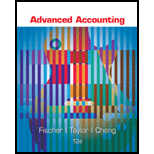
Introduction: Consolidated income statement is the combination of income, revenue and expenses of holding companies and its subsidiaries depicting the overall scenario of the aggregate of the company as a whole.
To prepare:The worksheet necessary to produce the consolidated financial statements for the year ended December 31, 2016, and to include the determination and distribution of excess and income distribution schedules.
Explanation of Solution
Adjustments of accounts to be amortized:
| Accounts Adjustments to be Amortized | Life (Years) | Annual Amount ($) | Current year ($) | Prior Years ($) | Total |
| Buildings | 20 | 6,500 | 6,500 | 13,000 | 19,500 |
| Equipment | 5 | 10,000 | 10,000 | 20,000 | 30,000 |
| Total Amortizations | 16,500 | 16,500 | 33,000 | 49,500 |
Following is the computation of intercompany inventory profit:
| Particulars | Parent Amount | Parent % | Parent Profit ($) | Sub Amount ($) | Sub Percent | Sub Profit ($) |
| Beginning | - | 0% | - | 12,000 | 25% | 3,000 |
| Ending | - | 0% | - | 9,000 | 25% | 2,250 |
Now, following is the computation of internally generated income of the company:
For Company S,
Given: Sale of S Company is $350,000, COGS is $230,000,
For Company P,
Given: Sales of P Company is $900,000, COGS is $530,000, Depreciation expenses on building are $30,000, Depreciation expenses on equipment are $15,000 and other expenses are $155,000.
Following is the computationof income distribution of subsidiary of S Company:
| Particulars | Amount ($) | Particulars | Amount ($) |
| Amortizations
Ending Inventory profit Interest adjustment, bonds | 16,500
2,500 998 | Internally Generated Net Income
Beginning Inventory Profit Adjusted Income Non-Controlling Interests share Non-controlling Interest | 17348
3,000 350 20% 70 |
Following is the computation of income distribution of parent P Company:
| Particulars | Amount ($) | Particulars | Amount ($) |
| Internally Generated Income
Adjusted Income Share (S Company) (80% of $15,987) Controlling Interest | 178,650
280 178,930 |
Worksheet:
| Particulars | Elimination and Adjustments | Consolidated B/S ($) | NCI ($) | Controlling R/E ($) | Consolidated B/S ($) | |||
| P ($) | S ($) | Debit ($) | Credit ($) | |||||
| Cash | 290486 | 99347 | 389833 | |||||
| 120000 | 91000 | 6000 | 205000 | |||||
| Inventory | 140000 | 55000 | 2500 | 192500 | ||||
| Land | 200000 | 60000 | 260000 | |||||
| Investment in S stock | 435737 | 13878 | ||||||
| - | (8000) | |||||||
| - | 189859 | |||||||
| - | 240000 | |||||||
| Investment in S Bonds | 96760 | 96760 | ||||||
| Buildings | 600000 | 100000 | 130000 | 830000 | ||||
| (340000) | (45000) | 19500 | (404500) | |||||
| Equipment | 150000 | 80000 | 50000 | 280000 | ||||
| Accumulated Depreciation | (105000) | (60000) | 30000 | (195000) | ||||
| 120000 | 120000 | |||||||
| Accounts Payable | (40000) | (34000) | 6000 | (68000) | ||||
| Bonds Payable | (100000) | 100000 | ||||||
| Discount (Premium) | (1675) | 1675 | ||||||
| Common Stock ($1 par) S. Co. | (10000) | 8000 | ||||||
| Paid-in-capital in excess of par - S. Co. | (90000) | 72000 | (2000) | |||||
| (137324) | 109859 | (18000) | ||||||
| 6600 | 560000 | |||||||
| 600 | 1183 | |||||||
| Common Stock ($1 par) P Company | (100000) | (81448) | (100000) | |||||
| Paid-in-capital in excess of Par - P. Co. | (800000) | (800000) | ||||||
| Retained Earnings | (475455) | 26400 | ||||||
| 2400 | (451385) | |||||||
| 4730 | ||||||||
| Sales | (900000) | (350000) | 25000 | (1225000) | ||||
| Cost of goods sold | 530000 | 230000 | 25000 | |||||
| 2500 | 3000 | 734500 | ||||||
| Depreciation - Building | 30000 | 5000 | 6500 | 41000 | ||||
| Depreciation - Equipment | 15000 | 10000 | 10000 | 35000 | ||||
| Other Expenses | 155000 | 80000 | 235000 | |||||
| Interest Expense | 7652 | 7652 | ||||||
| Interest Revenue | (8650) | 8650 | ||||||
| Subsidiary Income | (13878) | 13878 | ||||||
| Dividend Declare - S. Co. | 10000 | 8000 | 2000 | |||||
| Dividend Declare - P. Co. | 20000 | 20000 | ||||||
| Total | 0 | 0 | 708062 | 70862 | ||||
| Consolidated Net Income | (179000) | |||||||
| Non - Controlling Interest | 70 | 70 | ||||||
| Controlling Interest | 178930 | (178930) | ||||||
| Total Non-Controlling Interests | (99518) | (99518) | ||||||
| Retained Earnings | (610315) | (610315) | ||||||
| Total | 0 | |||||||
Eliminations and Adjustments are made in the following:
- Current-year subsidiary income.
- Current-year dividend.
- Eliminate controlling interest in subsidiary equity.
- Distribute excess and adjust NCI.
- Eliminate intercompany sales during the current period.
- Eliminate intercompany unpaid trade accounts.
- Defer beginning inventory profit.
- Defer ending inventory profit.
Computation of proof for the Elimination of Bonds:
| Particulars | Amount ($) | Amount ($) |
| Gain remaining at year (end): | ||
| Carrying Value at December 31, 2016 | 101,675 | |
| Investment in bonds at December 31, 2016 | 96,760 | 4,915 |
| Loss amortized during the year: | ||
| Interest expense eliminated | 8,650 | |
| Interest Revenue Eliminated | 7,652 | 998 |
| Gain at January 1, 2016 | 5,913 |
Want to see more full solutions like this?
Chapter 5 Solutions
Advanced Accounting
- Principles of Accounting Volume 1AccountingISBN:9781947172685Author:OpenStaxPublisher:OpenStax College
